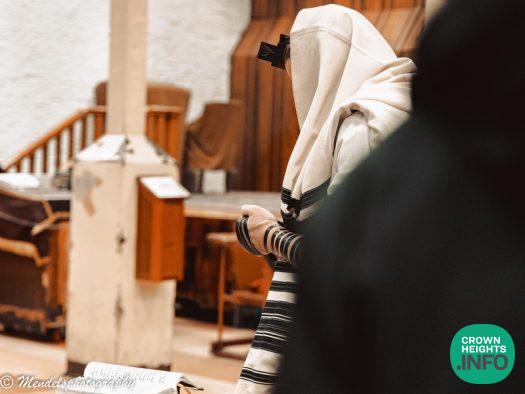
Weekly Story: How To Daven
by Rabbi Sholom DovBer Avtzon
This shabbos is Shabbos mevorchim, Elul. As is well known, during this month we increase in all of our mitzvos, but Shulchan Aruch notes and stresses that we should especially increase in the three aspects of learning Torah, tefilla and tzedoka
So, when I was told the following story a few weeks ago about How To Daven, I immediately decided to use it for this week’s post, Shabbos Mevorchim Elul.
However, I should note that when I first heard this story, I did not have a clear understanding of the story and the message every chassidishe story, particularly if it is a guidance that one of our Rebbeim gave to a chossid contains, So I went over to a friend who I believed would know this story and asked him to explain it to me.
His reply caught me a little off guard, as he said that he had never heard in the family or from chassidim who were very close to his grandfather that this story was told to or is somehow connected to his grandfather. However, he did hear it, and this is the way he understands it (the connection between davening and the delivery of mail.
The words below are the way he explained it to me and are not the exact words that I was originally told in the name of the Frierdiker Rebbe. In other words, you may have heard this story a little bit differently and possibly more accurately than the way I am writing it. But I could only relate something that I understand its message to a certain degree.
As always, your feedback and comments are most appreciated and welcomed.
One of the devoted chassidim in communist Russia, was Reb Yaakov Zecharia ben Reb Zev Wolf Halevi. His father came from Skalik, so as a bochur he was known as Yaakov Miskalik (from Skalik). But after the Rebbe Rashab appointed him in 5671 (1911) as the Rov in Zhuravitch he became known as Reb Yaakov, or as he is better known as Reb Yankel Zhuravitcher.
It should be noted that when he was a student in Tomchei Tmimim, the Rebbe Rashab spoke about his tremendous Ahavas Yisroel.
The Rebbe Rashab often sent him to various places to assist in communal matters and this continued during the Frierdiker Rebbe’s nesius.
In addition of being one of the Frierdiker Rebbe’s secretaries, and involved in his activities, some say he was one of the nine chassidim who joined the Frierdiker Rebbe in vowing that they would devote their life to spreading Yiddishkeit in Communist Russia, to the point of mesiras nefesh.
Even if he wasn’t, there is no question that he was one of the driving forces inspiring other chassidim to also become involved in maintaining their standard of continuing their life and raising their children in the Chassidishe way of Lubavitch, as well as to maintain the underground chadorim. He was arrested numerous times by the NKVD, but the last time was in 5695 (1935) and three years later, while he was still in prison and couldn’t do any activity that they didn’t approve of, they killed him.
Now to the story.
One time the Frierdiker Rebbe said to him, Yaakov / Yankel, you are to be scrupulous in every aspect of Shulchan Aruch, without relying on any leniencies, even if you believe it is based on chassidshe conduct!
Reb Yaakov asked, does that mean that from now on, I should daven Shacharis early, so that I say (Shema and) Shemone Esreh in its proper time, and not daven with avodah (at length) as is expected from chassidim?
Definitely not, the Rebbe replied, davening has to be through avodah.
The Rebbe then explained that generally speaking there are three levels of davening and he used the three ways of mailing a letter to explain the difference between them.
When you want / need to send a letter to someone you could send it by regular mail, express mail or by telegram.
The difference between them is as follows; regular mail takes the longest time for the letter in the envelope to reach its destination. Each postal worker who handles it, has to read the address and make sure to put it in the correct box/bag. Therefore, it is going to take a longer time for it to reach its final destination.
While an express envelope has a marker or a clear code on it, which takes away any guessing by the postal workers as to where it is to go. Obviously, it is delivered much faster than regular mail.
And then there is a telegram, where there is no need for the postal workers transporting the letter from one city to the other, which can be hundreds or thousands of miles distance from where it is being sent from. So although it may be sent the last, it arrives the first!
The same thing is among those who daven, they too can be divided into these three distinctive differences. There are those who work very hard but will never begin the day without davening first. So, an hour or so before they have to go to work, they daven. This is wonderful, but sometimes their davening is rushed, which can cause that there are mispronounced (or perhaps a word missed). But there is this beautiful connection between the Jew who davened and Hashem. The angels are “the postal workers”, they are responsible to bring these tefillos to Hashem
But they notice some imperfections in it, as noted it might have been rushed or said without the proper concentration and emotion. The angels desire that Hashem accepts and grants each person’s prayer, so they diligently work to smooth out those wrinkles and then they present it to Hashem in a proper setting. However, this process may take some time.
A Higher and more proper way to daven, is the Jew who davens Shemone Esreh at sunrise (neitz hachamah). Doing so demonstrates that the person has an enthusiasm in davening and connecting to Hashem. At the first moment the person is allowed to daven, they do so. Here the angels don’t have much improvement to make with the davening as it already has a proper setting, it just may need a little touch up, so figuratively speaking, it is sent via express, meaning it arrives in front of Hashem very soon after the person davened.
But the best way is the chassidishe davening.
The Jew isn’t merely saying words, he is pouring out his heart to Hashem, just as children do when they are beseeching their parents for something. The child knows that their parents have the ability to provide that desired item to them, and the Jew knows Hashem is the sole true provider in the world. That type of connection doesn’t need any assistance in its presentation.
So while the Jew who davens with avodah as a chossid should, concludes their davening later. And sometimes hours later than the first two groups of Jews, there tefilla arrives to Hashem first.
Just as the telegram which may have been sent after the two other ways of mailing a letter, (and sometimes days later), yet it arrives at the ultimate destination first.
May everyone’s tefilla be accepted and fulfilled by Hashem, especially now in the month of Elul, which the Alter explained, that Hashem (the king) is in the field, and happily greets everyone and fulfills their request.
A Taste of Chassidus V’samti kadkot Shimshoshayich 5734
In possuk 12 of this week’s haftara we say “And I will make your windows of jasper and your gates of carbuncle stones, and all your border of precious stones.”
While I used the common used translation for katkod (Jasper), in truth there are two opinions of what it is. Either it is Jasper (the Yushpeh) stone of the urim v’tumim which had Yosef’s name engraved on it, or the onyx (Shoham) stone, on which Binyomin’s name was written on it.
The Hebrew word of Kadkod כדכד is an abbreviated compound of the two words כדין כדין, which means like this one (opinion) and like this one (opinion).
So we have to understand what does each ,one of these stones symbolize.
Yosef and Binyomin are very similar, both of them are called tzaddik, but there was a difference between them.
A tzaddik connects Hashem and the Jewish people, but there are two ways to accomplish that. Yosef is called tzaddik elyon, meaning he is bringing Hashem to the people. Binyomin on the other hand is called tzaddik tachton, as he connects the Jewish people to Hashem.
In Chassidic terminology this is called milmaaluh Limatuh and milmatuh limaaluh. This difference is applied in numerous situations, the difference between Torah [which came down to the earth from the heaven, and Tefilla (davening), which the Torah refers to a ladder whose feet are on the ground, and it reaches the heavens.
It is also used to describe the difference between Torah and mitzvos, and those who learn Torah and those who support them.
Each one has a quality that is lacking in the other, and the following parable is used to express it.
Two people want to meet; one is on the top of a mountain and the other one is at the bottom of the valley. Either the one on the mountain walks down or the on in the valley climbs up.
The one on the mountain is able to walk down as far as necessary to reach his counterpart, without any difficulty or exertion. While the one in the valley needs strength to climb up, and may not have the strength or ability to climb all the way up.
Yet there is a quality in climbing up, and that is that it is your accomplishment through your tremendous effort, that allowed it to happen.
This is what the argument centered on, yes, when Moshiach will come the world would be elevated, as the possuk states there will be a stronger light than is produced by the sun, but which avodah will be rewarded and be symbolized by the light shining forth from their respective stone?
So Hashem states, we will acknowledge the avodah of both, each one is of paramount importance.
Yes, creations in general were given a certain tendency, however, Hashem who is higher than nature gives a person the ability to utilize these two opposing tendencies simultaneously.
Rabbi Avtzon is a veteran mechanech and the author of numerous books on the Rebbeim and their chassidim. He is available to farbreng in your community and can be contacted at avtzonbooks@gmail.com.














